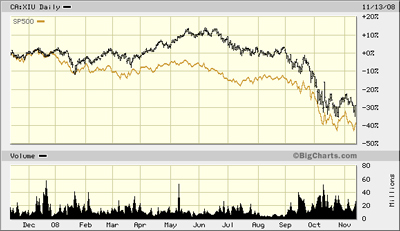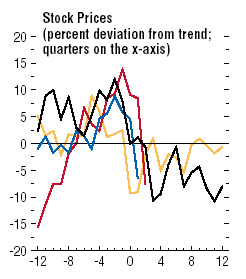Econbrowser‘s James Hamilton has posted again on the Effective Fed Funds Rate Puzzle – his prior post was discussed on PrefBlog in a post the Professor was kind enough to praise.
In summary: we’re not really all that much forrarder in understanding this!
There’s a couple of points I’d like to comment upon:
Me, I’d like to borrow a few gazillion. And lest somebody else get to the GSEs for some of this easy action ahead of me, I’m happy to leave a standing order with my broker. I’ll pay, say, 0.5% to anybody, any time, to borrow any volume of overnight fed funds.
You can! Just become a Bank Holding Company (very fashionable nowadays).
Just remember that to strap on $1-billion, you’ll need $50-million Tier 1 capital, absolute minimum, in order to stay within the leverage guidelines. Assuming that’s pure profit (and you have a tax rate of ZERO), that makes a 13% ROE … almost as good as Credit Card Banks in 1H08 (Table IV-A) and in line with average performance during the boom:
If you have no other expenses AND counterparties will lend to you, that is. One problem is that this is what might be called a “moat protected business” – at best, it’s a nice way for extant players to make a few extra bucks, but the spread is insufficient to attract new players – or even to attract new capital to extant players – it’s a fill-in, temporary operation at best.
In addition to the two ideas cited by Dr. Hamilton, there’s also the idea that the short bill rate acts as a cap. Players who need very short term liquidity in very large amounts might be relatively indifferent to holding bills or lending Fed Funds to a solid bank (by “relatively”, I mean that the desired rates are not necessarily equal, but there should be some kind of spread at which they are indifferent. Fed Funds are more liquid, but carry some credit risk).
So, whenever the bid on brokered funds rises above a certain level, these players sell bills and lend to banks, knocking the bid right back down again.
I also consider it very important to remember that the Effective Fed Funds rate is comprised solely of brokered transactions – direct transactions are not included in the calculation or even reported (directly) to the Fed. I’m willing to bet (a nickel) that the rate on direct transactions is a LOT closer to 1% than to 0.35%, and I’ll bet another nickel that there are a lot of bright young Fed researchers cackling with glee over the prospect of getting a good paper out of the situation in the next year or two.
In normal times the policy response to an undesirably low Effective Fed Funds Rate is to drain reserves – by selling T-Bills, for instance, to remove cash from the system. This would run counter to virtually every other programme now in place, which aim to flood the system with cash.
So here’s a hypothesis: we no longer have a liquidity problem, per se, we have a capital/confidence problem. There are plenty of players with plenty of cash, but they’re not willing to extend private-market credit due both to their own fears of credit risk, and to their fears of what their creditors might fear about their credit risk (if you follow. That’s kind of convoluted, isn’t it?).
If this hypothesis is correct – and it’s a big if – then it seems to me that the policy response is:
- Flood the system with short bills to soak up liquidity and get short bills to trade at a spread over Fed Funds, at the very least
- Put more capital into the system – perhaps with a matching funds programme, whereby Treasury stands willing to buy half of any public Tier 1 capital issue from a qualified bank
- Gradually increase the spreads required on the Commercial Paper Funding Programme so that the Fed will no longer crowd out private players
At this point, I’m still a little flummoxed. I can’t think of any other hypothesis, but I also can’t think of a good way to test the hypothesis I have and will have to spend some more time thinking about that one. Execution of part 2 of the policy response would be a little tricky as well … I’m unwilling to give up on Bagehot, so I want the capital put in at a punitive rate, but that might cause more problems than it solves. And I might be blinded by wanting idealogical purity with respect to Bagehot. Rule #1: Do whatever works and don’t fuss too much about idealogical purity.
I can take comfort in the idea that Macroblog is flummoxed too, anyway!
Update, 2008-11-17: Bloomberg has a story on Fed Funds & the FDIC Guarantee:
The FDIC is considering charging different fees depending on the maturity of the debt, instead of its previous plan for a flat fee. Companies including JPMorgan Chase & Co. and Bank of America Corp. said the original proposal threatened to make the overnight federal funds market too costly compared with alternatives such as direct loans from the Federal Reserve.
…
The FDIC had proposed charging a standard fee to insure all eligible senior unsecured debt. Banks argued that the federal funds market should be treated differently. If that market costs too much, banks might switch to government lending programs like the Fed’s discount window or Federal Home Loan Bank advance programs, they said.
“Such an outcome would not achieve the FDIC’s goal of improving shorter-term unsecured inter-bank funding markets,” law firm Sullivan & Cromwell wrote in a letter to the agency on behalf of nine large banks, including Goldman Sachs Group Inc., JPMorgan and Bank of America.
High premiums on federal funds lending “could effectively shut down the overnight funds market,” said Louis Crandall, chief economist of Wrightson ICAP in Jersey City, New Jersey. “Most current activity in the overnight funds market would either not take place or be diverted to other instruments such as Eurodollars that are not subject to the FDIC’s new fees.”
The FDIC has received and published a LOT of comments on the Temporary Liquidity Guarantee Programme. The Sullivan & Cromwell letter is here.
Update, 2008-11-18: A commenter on the Econbrowser thread has drawn my attention to a research note by Daniel L. Thornton of the St. Louis Fed, Subprime Side Effects in the Federal Funds Market noting – in pre-interest-on-reserves days – the substituent effect of T-Bills on the Effective Fed Funds Rate.
Update, 2008-11-21: The FDIC Final Rule has been announced:
- The FDIC’s obligation to pay on FDIC-guaranteed debt will be triggered by payment default, rather than bankruptcy or receivership, as provided in the Interim Rule. This change should improve the value of the guarantee and help institutions obtain funding.
- Short-term debt (30 days or less) has been eliminated from the debt guarantee program, but the limit on the amount of debt that the FDIC will guarantee, generally 125 percent of senior unsecured debt outstanding on September 30, 2008, will include short-term debt outstanding on that date.
- The fee under the debt guarantee program will depend upon maturity of the debt. The fee will be lower for shorter-term debt and higher for longer-term debt.
- By December 5, 2008, all eligible entities—all insured depository institutions and almost all holding companies—must take action with respect to both the transaction account guarantee program and the debt guarantee program.
…
| For debt with a maturity of: |
The annualized assessment rate
(in basis points) is: |
| Less than 180 day |
50 |
| 181-364 days |
75 |
| 365 days or greater |
100 |
However, the rates set forth above will be increased by 10 basis points for senior unsecured debt issued by a holding company or by a participating affiliate that is not an insured depository institution if, as of September 30, 2008, the assets of the holding company’s combined depository institution subsidiaries constitute less than 50 percent of consolidated holding company assets.
Update, 2008-11-23 There’s some background, but precious little meat, from the St. Louis Fed – Paying Interest on Deposits at Federal Reserve Banks, by Richard G. Anderson.














































































































